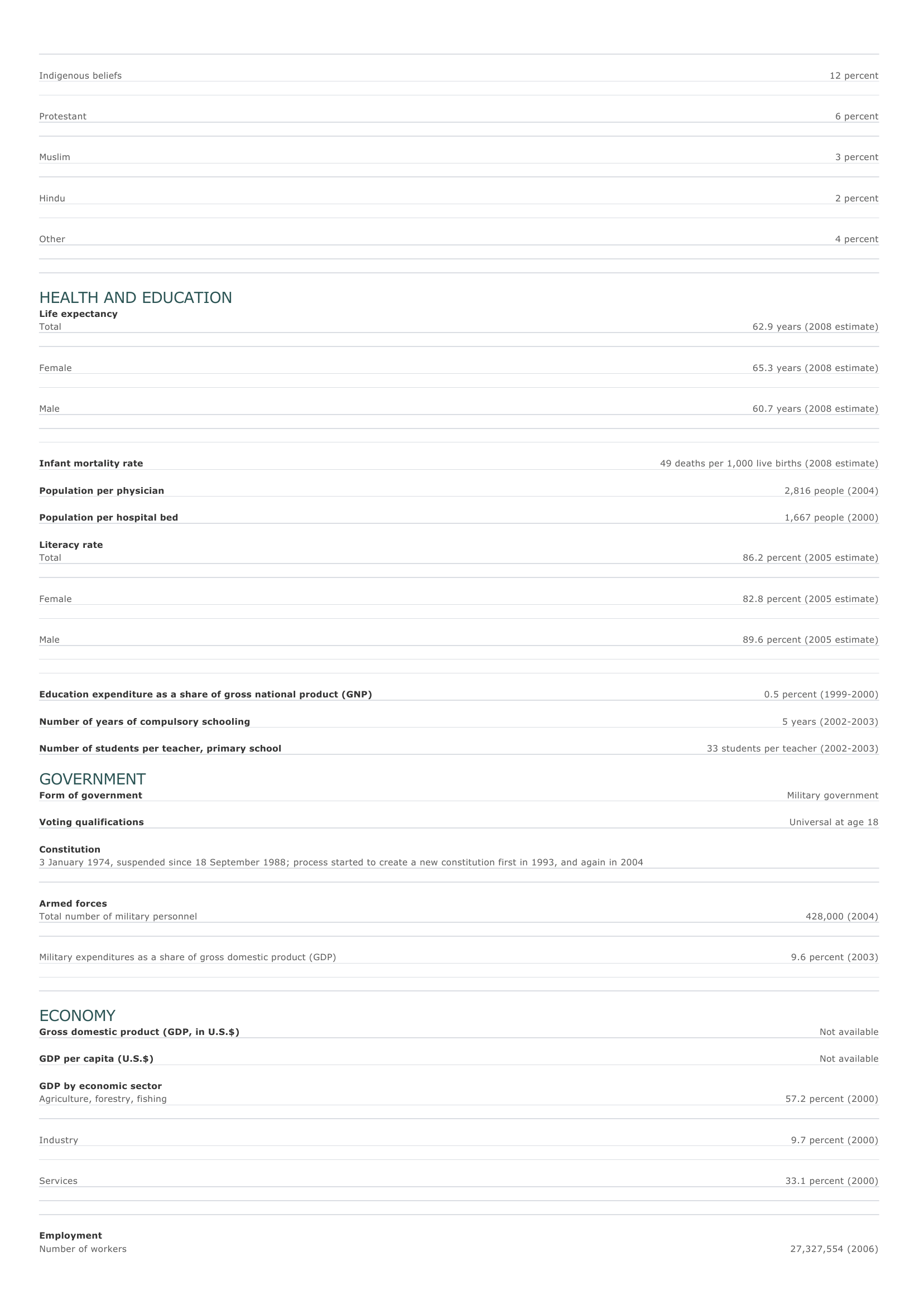Myanmar Facts and Figures. BASIC FACTS Official name Capital Area Union of Myanmar Pyinmana (administrative); Yangon (commercial) 676,552 sq km 261,218 sq mi PEOPLE Population 47,758,181 (2008 estimate) Population growth Population growth rate 0.80 percent (2008 estimate) Projected population in 2025 52,995,497 (2025 estimate) Projected population in 2050 54,430,334 (2050 estimate) Population density 73 persons per sq km (2008 estimate) 188 persons per sq mi (2008 estimate) Urban/rural distribution Share urban 31 percent (2005 estimate) Share rural 69 percent (2005 estimate) Largest cities, with population Yangon 3,874,000 (2003 estimate) Mandalay 801,707 (2000 estimate) Moulmein 219,961 (1983) Pegu 150,528 (1983) Bassein 144,096 (1983) Ethnic groups Burman 68 percent S han 9 percent Karen 7 percent Arakanese (Rakhine) 4 percent Chinese 3 percent Mon 2 percent I ndian 2 percent O ther 5 percent Languages Burmese (official); minority ethnic groups have their own languages Religious affiliations Buddhist 73 percent Indigenous beliefs 12 percent Protestant 6 percent Muslim 3 percent Hindu 2 percent O ther 4 percent HEALTH AND EDUCATION Life expectancy Total 62.9 years (2008 estimate) Female 65.3 years (2008 estimate) Male 60.7 years (2008 estimate) Infant mortality rate 49 deaths per 1,000 live births (2008 estimate) Population per physician 2,816 people (2004) Population per hospital bed 1,667 people (2000) Literacy rate Total 86.2 percent (2005 estimate) Female 82.8 percent (2005 estimate) Male 89.6 percent (2005 estimate) Education expenditure as a share of gross national product (GNP) Number of years of compulsory schooling Number of students per teacher, primary school 0.5 percent (1999-2000) 5 years (2002-2003) 33 students per teacher (2002-2003) GOVERNMENT Form of government Military government Voting qualifications Universal at age 18 Constitution 3 January 1974, suspended since 18 September 1988; process started to create a new constitution first in 1993, and again in 2004 Armed forces Total number of military personnel Military expenditures as a share of gross domestic product (GDP) 428,000 (2004) 9.6 percent (2003) ECONOMY Gross domestic product (GDP, in U.S.$) Not available GDP per capita (U.S.$) Not available GDP by economic sector Agriculture, forestry, fishing 57.2 percent (2000) I ndustry 9.7 percent (2000) Services 33.1 percent (2000) Employment Number of workers 27,327,554 (2006) Workforce share of economic sector Agriculture, forestry, fishing 63 percent (1998) I ndustry 12 percent (1998) Services 25 percent (1998) Unemployment rate 6 percent (1990) National budget (U.S.$) Total revenue $42,447 million (2002) Total expenditure $42,447 million (2002) Monetary unit 1 kyat (K), consisting of 100 pyas Major trade partners for exports Thailand, United States, India, China, and Singapore Major trade partners for imports China, Singapore, Thailand, South Korea, and Malaysia ENERGY, COMMUNICATIONS, AND TRANSPORTATION Electricity production Electricity from thermal sources 63.38 percent (2003 estimate) Electricity from hydroelectric sources 36.62 percent (2003 estimate) Electricity from nuclear sources 0 percent (2003 estimate) Electricity from geothermal, solar, and wind sources 0 percent (2003 estimate) Number of radios per 1,000 people 65 (2000 estimate) Number of telephones per 1,000 people 9 (2005) Number of televisions per 1,000 people 7 (2000 estimate) Number of Internet hosts per 10,000 people 0 (2000) Daily newspaper circulation per 1,000 people 9 (1998) Number of motor vehicles per 1,000 people Paved road as a share of total roads 1.6 (1997) 11 percent (1999) SOURCES Basic Facts and People sections Area data are from the statistical bureaus of individual countries. Population, population growth rate, and population projections are from the United States Census Bureau, International Programs Center, International Data Base (IDB) (www.census.gov). Urban and rural population data are from the Food and Agriculture Organization (FAO) of the United Nations (UN), FAOSTAT database (www.fao.org). Largest cities population data and political divisions data are from the statistical bureaus of individual countries. Ethnic divisions and religion data are largely from the latest Central Intelligence Agency (CIA) World Factbook and from various country censuses and reports. Language data are largely from the Ethnologue, Languages of the World, Summer Institute of Linguistics International (www.sil.org). Health and Education section Life expectancy and infant mortality data are from the United States Census Bureau, International Programs Center, International database (IDB) (www.census.gov). Population per physician and population per hospital bed data are from the World Health Organization (WHO) (www.who.int). Education data are from the United Nations Educational, Scientific and Cultural Organization (UNESCO) database (www.unesco.org). Government section Government, independence, legislature, constitution, highest court, and voting qualifications data are largely from various government Web sites, the latest Europa World Yearbook, and the latest Central Intelligence Agency (CIA) World Factbook. The armed forces data is from Military Balance. Economy section Gross domestic product (GDP), GDP per capita, GDP by economic sectors, employment, and national budget data are from the World Bank database (www.worldbank.org). Monetary unit, agriculture, mining, manufacturing, exports, imports, and major trade partner information is from the statistical bureaus of individual countries, latest Europa World Yearbook, and various United Nations and International Monetary Fund (IMF) publications. Energy, Communication, and Transportation section Electricity information is from the Energy Information Administration (EIA) database (www.eia.doe.gov). Radio, telephone, television, and newspaper information is from the United Nations Educational, Scientific and Cultural Organization (UNESCO) database (www.unesco.org). Internet hosts, motor vehicles, and road data are from the World Bank database (www.worldbank.org). Note Figures may not total 100 percent due to rounding. Microsoft ® Encarta ® 2009. © 1993-2008 Microsoft Corporation. All rights reserved.











